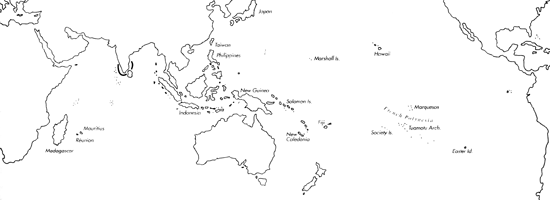Range: S. India.
Description: Medium-sized to moderately large, moderately solid to solid. Last whorl ventricosely conical to conoid-cylindrical; outline moderately convex at adapical third, less so to straight below; left side often slightly concave near base. Aperture somewhat wider at base than near shoulder. Shoulder angulate. Spire low, outline slightly concave to slightly sigmoid, with a straight-sided apex. Larval shell of about 2 whorls, maximum diameter about 0.9 mm. Teleoconch sutural ramps flat to slightly concave, with 3-4 weak to obsolete spiral grooves and many spiral striae in late whorls. Last whorl with weak spiral ribs on basal third.
| Shell Morphometry | ||
|---|---|---|
| L | 45-69 mm | |
| RW | 0.20-0.36 g/mm | |
| (L 45-57 mm) | ||
| RD | 0.55-0.60 | |
| PMD | 0.77-0.83 | |
| RSH | 0.07-0.12 | |
Ground colour white, often variably tinged with violet, sometimes more prominently so at base. Last whorl with a rather fine and regular network of dark brown lines edging numerous tiny to medium-sized ground colour tents. Overlying light brown to reddish brown spiral streaks, spots, flecks or blotches generally arranged in an interrupted spiral band on each side of centre and interspersed with spiral lines of alternating darker brown and white markings. Larval shell white. Early postnuclear sutural ramps immaculate white to pink. Following ramps matching last whorl in colour pattern. Aperture white.
Periostracum yellow, thin, translucent, smooth.
Dorsum of foot white with a few brown radial blotches, more prominent at lateral margins; anterior end edged with reddish pink, posterior end with a trilobate black blotch. Sole of foot brown, transversely mottled with buff. Rostrum brown proximally, tipped with pink. Tentacles white, tipped with pink. Siphon pink, mottled with brown proximally and tipped with red, with a black ring centrally (Kohn, 1978 & unpubl. Observ.; referred to as C. pennaceus).
Habitat and Habits: From the infralittoral fringe to about 50 m, more common below 20 m; on shallow-subtidal reef flats, in coarse sand and rubble, often among sea-weed and beneath rocks. C. madagascariensis is known to feed on gastropods (e.g. Trochidae). Spawn similar to that of C. pennaceus; egg diameter of 654 µm predicting a completely benthic development (Kohn, 1978; Perron & Kohn, 1985; referred to as C. pennaceus).
Discussion: C. madagascariensis resembles C. omaria and C. pennaceus. C. omaria has a reddish violet and narrower larval shell (0.7-0.8 mm), its aperture is not pure white, and Indian Ocean shells differ additionally in their narrower and consistently conoid-cylindrical last whorls (RD 0.45-0.56). The status of C. madagascariensis and C. omaria as separate species is also suggested by the correlative differences in egg diameters (654 vs. 336 µm) and types of development (benthic vs. planktonic). For comparison with C. pennaceus, see the Discussion of that species.

C. madagascariensis range map
This section contains verbatim reproductions of the accounts of 316 species of Conus from the Indo-Pacific region, from Manual of the Living Conidae, by Röckel, Korn and Kohn (1995). They are reproduced with the kind permission of the present publisher, Conchbooks.
All plates and figures referred to in the text are also in Röckel, Korn & Kohn, 1995. Manual of the Living Conidae Vol. 1: Indo-Pacific Region.
The range maps have been modified so that each species account has it own map, rather than one map that showed the ranges of several species in the original work. This was necessary because each species account is on a separate page on the website and not confined to the order of accounts in the book.